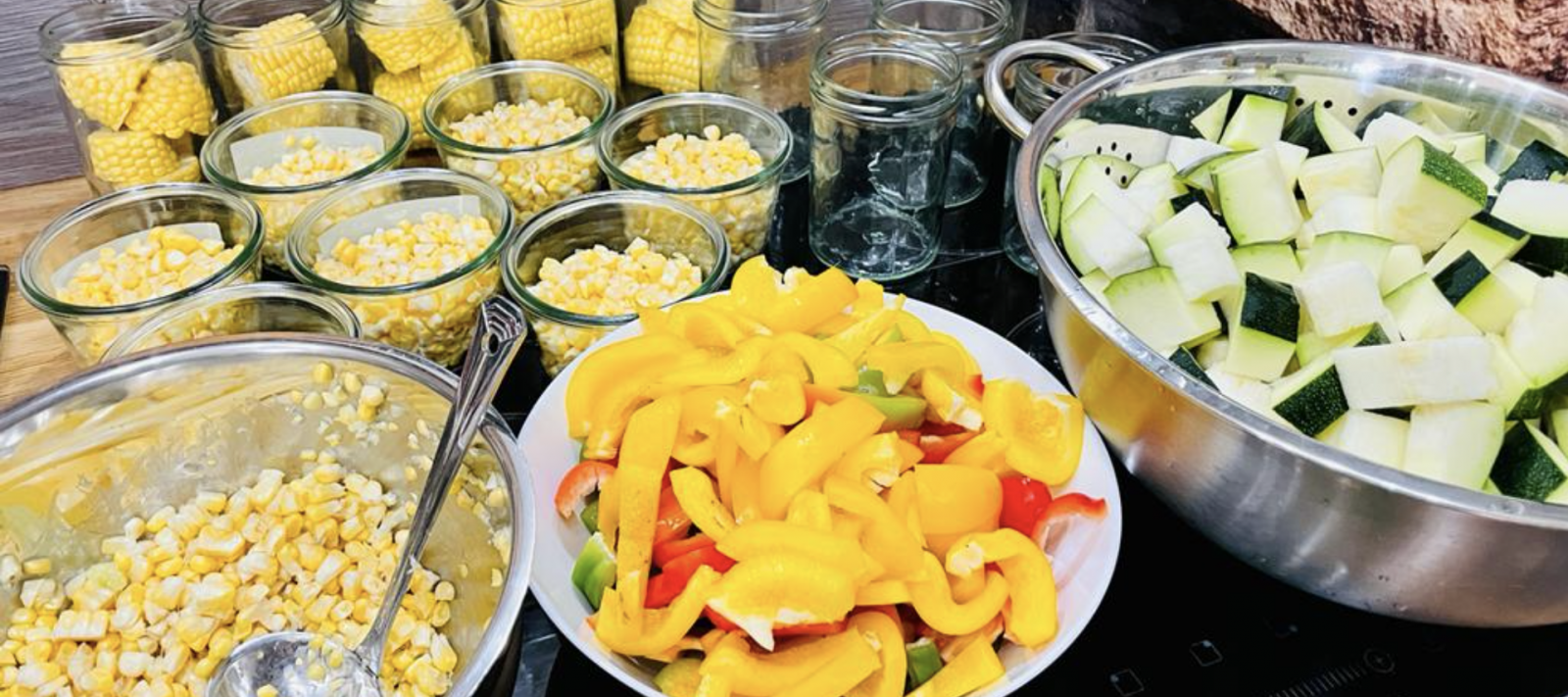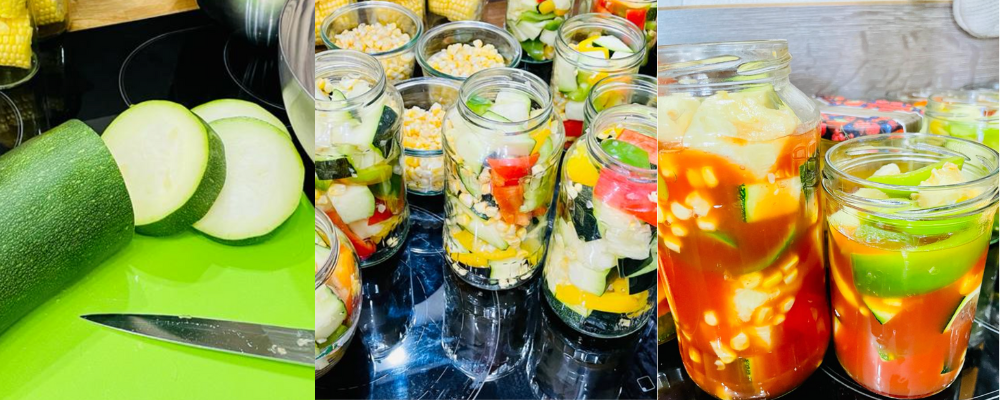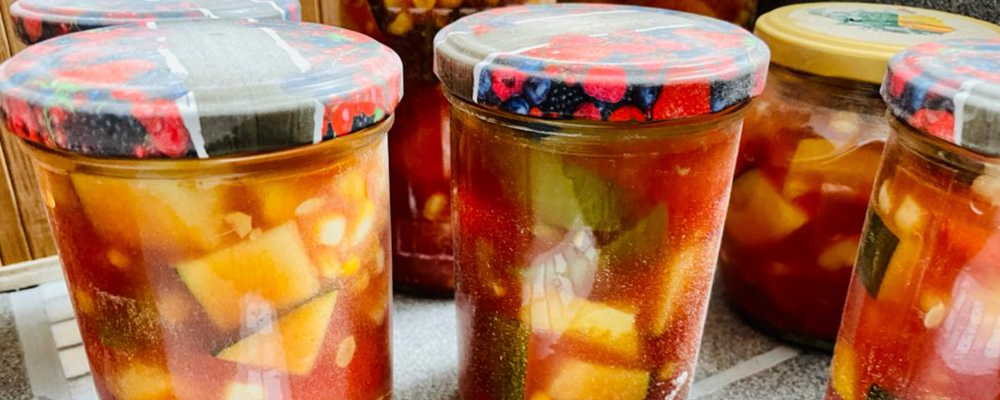Zucchini recipe: Sweet and sour vegetables
Zucchini recipe: Sweet and sour vegetables
Healthy zucchini plants give us masses of zucchinis in summer. If you want to enjoy tasty zucchinis later on, this recipe might be just the thing for you.
Ingridients

- Zucchini
- corn
- bell bell pepper
- 1/3 water
- 1/3 apple juice
- 1/3 apple cider vinegar
- salt, sugar, honey, tomato paste (without parsley)
Instructions

Step 1 - Preparing the ingredients
- wash the corn on the cob and peel off the kernels (works best with a corn cob peeler)
- wash the zucchini and cut into slices/dice.
Step 2 - Mixing - put 1/3 each of the apple juice, water and apple cider vinegar into a saucepan (the vinegar content should be at least 25% calculated at 5% vinegar).
- add salt, sugar, honey and tomato puree and season to taste.
- bring to the boil.
- add salt, sugar, honey and tomato puree and season to taste.
- bring to the boil.
Step 3 - Add to the jar - layer all the ingredients in a jar, leaving 2 - 3 cm/0.8 - 1.2 in of space to the edge of the jar.
Preparing the preserving
What we need:
- Pot with lid or canning machine
- Cotton cloth (not microfiber)
- Clean jars with lids (sealing rubber and clamps if necessary)
- Funnel
- Ladle
- Paper towels or 2-3 clean cloths
- Coaster for the pot
- Plate for the funnel
- A surface/countertop/area as a cooling surface. The jars must stand for 24 hours after boiling and must not be touched, moved, shifted or rearranged, etc. during this time!
Prepare the pot and jars:
- Place the pot on the cooking surface (switched off).
- Place a cotton cloth on the bottom of the pot (prevents the heat from hitting the bottom of the jar too hard and prevents the jars from knocking against each other).
- Wash the jars thoroughly and cleanly (sterilization is not necessary, as the boiling process already sterilizes the jars and they would become germy again when you remove them from the water).
- Also wash the lids thoroughly and cleanly (you can now place the jars and any rubbers in a bowl of water - WITHOUT vinegar).
- Place the jars on the work surface and the pot with the trivet next to them.
Automatic boiling-in machine: Steps 1 & 2 are slightly different for the preserving machine. Place the machine near the sink or in the bath/shower (this makes it easier to skim off the water or drain the water easily using the tap). Place the grid inside. (This prevents damage to the temperature sensor and the heat is not concentrated on the glass base).
Filling
- position the funnel on the jar and fill with the ladle.
- leave 2-3 cm/0.8-1.2 in space to the edge of the jar (the liquid expands and would otherwise be pressed out through the seal).
- place the funnel on a plate.
- wipe the edge of the jar well with a paper towel or clean cloth. The rim must be meticulously clean. TO jars: Screw the lid onto the jar (do not overtighten - some lids need to be placed in hot water for 5 minutes).
Weck jars: Position the rubber and place the lid on. Attach a clip correctly on the left and right.
Clamp jar: close - Check the lid/seal/clamps again.
The preserving process
- place the jars immediately afterwards in the pot or preserving machine (jars may touch each other)
a) Pot: Place the jars on the cotton cloth and make sure that they do not wobble.
b) Preserving machine: Place jars on the grid and make sure that they do not wobble. - If the preserves have been filled hot, hot water must now be poured in. If cold, add cold water. The water should always be approximately the same temperature as the contents (never leave to cool in the jar with the lid closed).
- Fill the water to at least ¾ of the height of the jar or above the lids. If you have placed several jars on top of each other, the highest layer always counts as the measure.
- here we go! (Tip: adding a tiny pinch of citric acid to the pot helps against chalky water) Pot: Now put the lid on the pot. This MUST remain closed during the entire cooking process! Bring the water to the boil. (Be careful not to bang the jars together). The water will steam, bubble and splash a little when it has reached its set temperature. When the water has reached this point, set your timer for 30 minutes (for sweet and sour vegetables - at least 25% vinegar content, otherwise 120 minutes). Now turn the temperature down a little, as we don't want to waste energy and prevent the jars from rattling. The water should still simmer, but no longer splash (don't turn it down too far, it has to simmer). Preserving machine: Set your temperature to 100 ° C/212 ° F (note the boiling point! Depending on the altitude, the water will boil at a few degrees less. You will only waste energy unnecessarily if you set 100 ° C/212 ° F and too much water evaporates) (e.g. at approx. 550 NHN it is 9 8° C/208 ° F). Set the time to 30 minutes (sweet and sour 25% vinegar content - less then 120 min).
- start!
Cooling & control
Pot
- pot: Switch off the hotplate.
- open the lid.
- carefully skim off some of the water so that you can reach the jars more easily.
- take the jars out immediately so that they can cool down quickly.
a) Carefully lift the jars out with the tongs and place them on the cooling surface. (Jars must NOT touch each other).
b) Skim off as much water as possible and carefully lift the jars out with an oven glove and place them on the cooling surface.
Preserving machine:
- when the time is up, the digital machines beep. You must switch off the manual ones yourself after the above time.
- open the lid. Watch out for hot steam!
- open the drain tap or carefully skim off the water.
- take the jars out immediately so that they can be cooled quickly.
- cooling down TO jars: leave for 24 hours! wake-up jars: leave for 24 hours! Do not remove the clamps! Leave jars to stand for 24 hours! Do not open the jars! Some jars make a "popping" sound when cooling down. This is completely normal, as the TO lid bulges inwards when the vacuum forms. The jars must not be moved, shifted, touched or otherwise handled during this time. Patience is required!
Finally: vacuum control. You can find out how to do this in my article on jar science.
